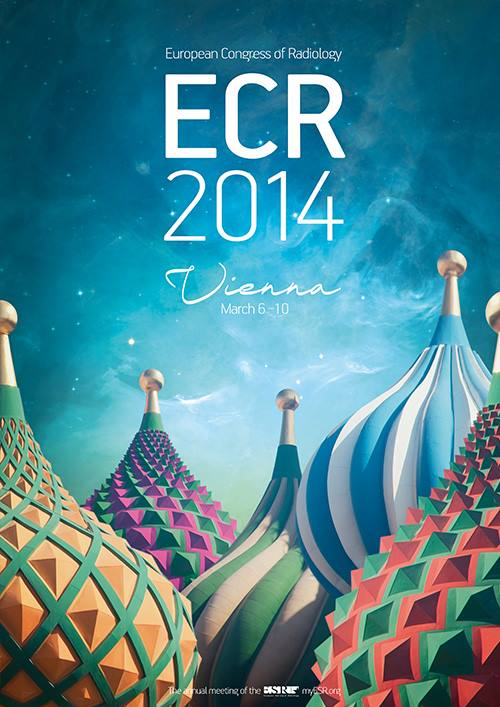
BMC Medical Imaging has recently returned from the European Congress of Radiology 2014 (ECR 2014), the 20th annual meeting of the European Society of Radiology held in Vienna. Extremely well organised, the congress became a forum for experts to learn and debate about the latest advances in imaging techniques and their clinical applications. Besides the interesting lectures, the conference introduced some remarkable innovations designed to make this a more dynamic and interactive congress.
One of these innovations was the Multimedia Classroom. The organisers set-up an auditorium with network connected workstations where multimedia sessions were presented, each including the discussion of three clinical cases that allowed the attendees to participate in the lecture and encouraged discussion. The extensive digital coverage of the conference, including a mobile app, live streaming of most of the sessions, and a ‘Social Media Wall’, made it easy for attendees to follow the development of the congress and navigate the vast amount of events going on at the same time.
The opening  talk of the conference was given by Dr. Oleg Atkov, a cardiologist and former cosmonaut, who pioneered medical imaging in space in the 1980s. After spending 8 months on board of the Soyuz T-10, Dr. Atkov studied the effect of zero gravity on the body through ultrasound, finding some complex changes in blood and fluid dynamics under weightlessness. He explained how radiology is still being used in space research with astronauts, in complex studies with MRI and fMRI that allow the study of subtle brain changes in space travellers.
talk of the conference was given by Dr. Oleg Atkov, a cardiologist and former cosmonaut, who pioneered medical imaging in space in the 1980s. After spending 8 months on board of the Soyuz T-10, Dr. Atkov studied the effect of zero gravity on the body through ultrasound, finding some complex changes in blood and fluid dynamics under weightlessness. He explained how radiology is still being used in space research with astronauts, in complex studies with MRI and fMRI that allow the study of subtle brain changes in space travellers.
We attended a broad range of sessions and talks, including the session presented by, Dr. Filipe Caseiro-Alves, an Associate Editor for BMC Medical Imaging. Dr. Caseiro-Alves presented an interesting talk within one of the refresher courses entitled ‘The many faces of benign liver lesions’. His talk focused on hepatocellualr neoplasms and the importance of differentiating focal nodular hyperplasia and hepatocellualr adenoma. The application of innovative imaging techniques, such as diffusion-weighted MR imaging (DWI), and the use of specific hepatobiliary contrast agents are allowing a more precise characterization of this type of lesions. This accurate differentiation is key to provide the appropriate patient management. The lecture also included very illustrative cases of such hepatocellular lesions, and examples of imaging cues for a successful differential diagnosis. Dr. Caseiro-Alves also acted as the moderator in a session about the efficacy and diagnostic performance in abdominal viscera imaging, and acted as the chairman for the postgraduate educational programme committee.
During the congress, BMC Medical Imaging also had the opportunity to speak to Professor Gustavo Deco, Professor Martijn van den Heuvel, and Dr. Patric Hagmann. The three participated in an exciting session about the technical challenges and possibilities of defining brain connections, the keystone to mapping the human connectome.
One lesson to be learned from the ECR 2014 is that even BMC Medical imaging must keep evolving to develop new media platforms to engage our audience and to communicate new scientific advances in a fast paced medical field. We would like to thank everyone who took interest in BMC Medical Imaging and open access publishing during the five intense days of the conference. We look forward to meeting you all again next year.
Comments